|
MQ-88B Fire Scout
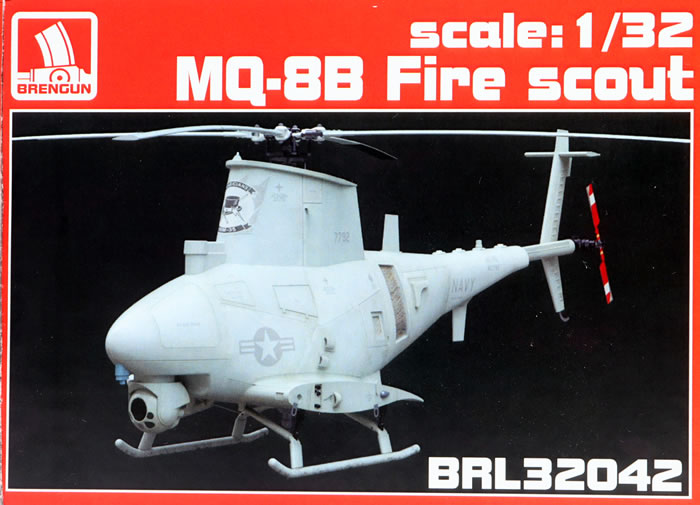
Brengun, 1/32 scale
S u m m a r y : |
Catalogue Number: |
Brengun Item No. BRL32042 - MQ-88B Fire Scout |
Scale: |
1/32 |
Contents & Media |
56 parts in grey resin; one 3D printed part; seven clear resin parts; 36 photo-etched parts on a single fret; one decal sheet; instructions. |
Price: |
Euro 83.22 plus shipping available online from Brengun
£74.30 EU Price (£61.92 outside Europe) plus shipping available online from Hannants
Click here for currency converter. |
Review Type: |
First Look. |
Advantages: |
Excellent quality casting; very high level of detail, no canopy to worry about! |
Disadvantages: |
Some experience with resin kits or conversions will be helpful, especially for removal from casting blocks and cleanup. |
Conclusions: |
Brengun's 1/32 scale MQ-8B Fire Scout is an interesting subject and a very well executed resin kit with a high level of detail.
Some experience working with resin parts will be necessary, but once the parts are removed from the sprues and cleaned up, assembly should be relatively straightforward.
This will be a unique and impressive specimen in 1/32 scale. |
Reviewed by Brett Green

The Northrop Grumman MQ-8 Fire Scout is an unmanned autonomous helicopter developed by Northrop Grumman for use by the United States Armed Forces. The Fire Scout is designed to provide reconnaissance, situational awareness, aerial fire support and precision targeting support for ground, air and sea forces. The initial RQ-8A version was based on the Schweizer 330, while the enhanced MQ-8B was derived from the Schweizer 333. The larger MQ-8C Fire Scout variant is based on the Bell 407.
As the US Navy was withdrawing its RQ-2 Pioneers from service, it began to seek a second generation UAV. The Navy requirement specified a vertical takeoff & landing (VTOL) aircraft, with a payload capacity of 90 kg (200 lb), a range of 125 miles (200 km), an endurance on station of three hours at an altitude of 20,000 feet (6,100 m), and the ability to land on a ship in a 46 km/h (29 mph) wind. The UAV was to fly 190 hours before planned maintenance.
There were three finalists in the competition, which was designated "VTOL-UAV" or "VTUAV". Bell, Sikorsky, and a collaboration of Teledyne Ryan and Schweizer Aircraft submitted designs. The Ryan-Schweizer UAV was selected as the winner in the spring of 2000. The RQ-8A Fire Scout, as it was named, was a derivative of the Schweizer three-passenger, turbine powered 330SP helicopter, with a new fuselage, new fuel system, and UAV electronics and sensors.
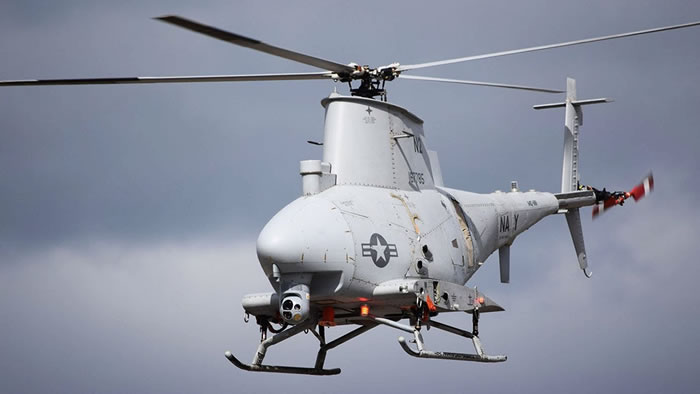
The initial prototype of the Fire Scout was piloted in initial tests, flying autonomously for the first time in January 2000. The Rolls-Royce 250-C20 turbine engine ran on JP-8 and JP-5 jet fuel (the latter of which has a higher flashpoint and is considered safe for shipboard storage and use).
The Fire Scout was to be fitted with a sensor ball turret that carries electro-optic and infrared cameras, and a laser range finder. It was to be controlled over a data link derived from the Northrop Grumman RQ-4 Global Hawk UAV, operating over a line of sight to a distance of 172 miles (280 km). The control system was to be fitted onto a ship, or could be carried on a Humvee light vehicle for US Marine service.
Although progress on the project had been regarded as satisfactory, the Navy decided the Fire Scout didn't meet their needs after all, and cut funding for production in December 2001. However, the development program continued, and Northrop Grumman pitched a range of improved configurations to anyone who was interested. As it turned out, the U.S. Army was very interested, awarding a contract for seven improved RQ-8B evaluation machines in late 2003. In 2006, it was redesignated MQ-8B.
The MQ-8B features a four-blade main rotor, in contrast to the larger-diameter three-blade rotor of the RQ-8A, to reduce noise and improve lift capacity and performance. The four-blade rotor had already been evaluated on Fire Scout prototypes. They increase gross takeoff weight by 500 pounds (230 kg), to 3,150 pounds (1,430 kg) with payloads of up to 700 pounds (320 kg) for short-range missions. The MQ-8B is 23.95 feet (7.30 m) long, 6.2 feet (1.9 m) wide, and 9.71 feet (2.96 m) tall.
The MQ-8B is fitted with stub wings which serve both an aerodynamic purpose as well as an armament carriage location. Weapons to be carried include Hellfire missiles, Viper Strike laser-guided glide weapons, and, in particular, pods carrying the Advanced Precision Kill Weapon System (APKWS), a laser-guided 70 mm (2.75 in) folding-fin rocket, which the Army saw as ideal for the modern battlefield. The Army was also interested in using the Fire Scout to carry up to 200 pounds (91 kg) of emergency supplies to troops in the field.
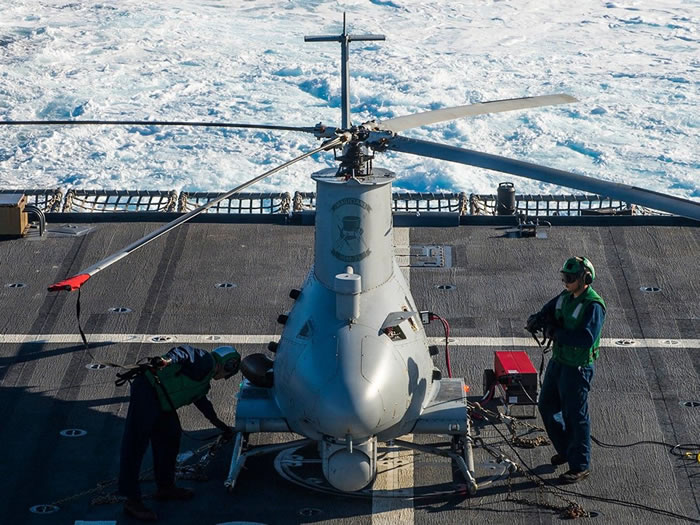
The MQ-8B is being modified to permit rapid swap out of payload configurations. The current sensor configuration of a day/night turret with a laser target designator will remain an option. Alternate sensor payloads in consideration include a TSAR with Moving Target Indicator (MTI) capability, a multispectral sensor, a SIGINT module, the Target Acquisition Minefield Detection System (ASTAMIDS), and the Tactical Common Data Link (TCDL). The Army wanted the Fire Scout to operate as an element of an integrated ground sensor network as well.
In April 2006, production on the flight test airframes was initiated at Northrop Grumman's Unmanned Systems production plant in Moss Point, Mississippi. The first flight of the MQ-8B took place on 18 December 2006 at Naval Air Station Patuxent River. The Army interest revived Navy interest in the program, with the Navy ordering eight Sea Scout MQ-8B derivatives for evaluation. In January 2010, the Army terminated its involvement with the Fire Scout, contending that the RQ-7 Shadow UAV could meet the Army's needs. In 2009, the Navy approved low-rate initial production.
As of February 2018, 23 MQ-8B variants were in service with the U.S. Navy.*
Brengun has completed its sweep of the major scales with this 1/32 MQ-8B Fire Scout.
Brengun released a 1/72 scale Fire Scout in 2019, which was reviewed here on HyperScale by David Couche and later built by him in a Feature Article; plus a 1/48 scale MQ-8B in the same year. These were both re-boxings of the 2013 Attack Squadron kits.
This bigger brother is an all-new affair - a first in 1/32 scale .
The multi-media kit comprises 56 parts in grey resin, one salmon-coloured 3D printed part, seven clear resin parts, 36 photo-etched parts on a single fret, one decal sheet covering four subjects and instructions.
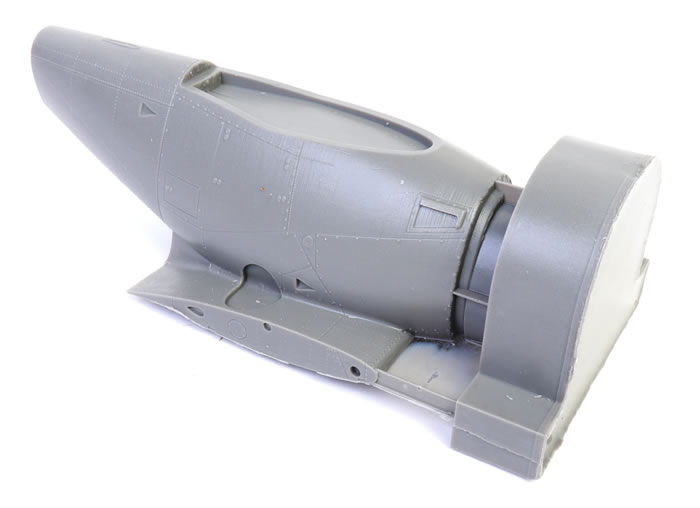
Casting quality is excellent.
The jewel in the crown is the big solid fuselage casting. This impressive lump of resin features lovely crisp raised and recessed surface textures.
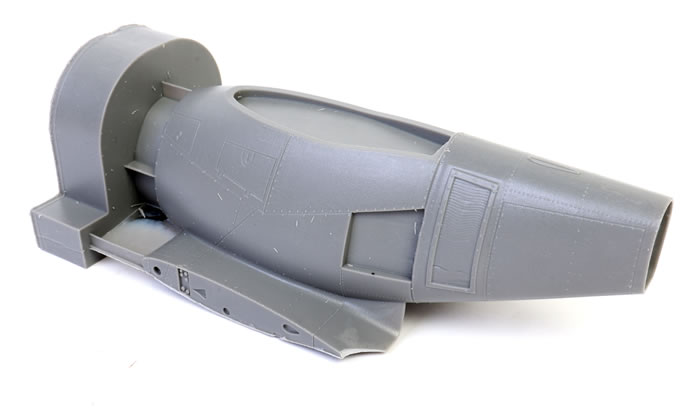
The bad news is the rear corner of the port side winglet has broken off.
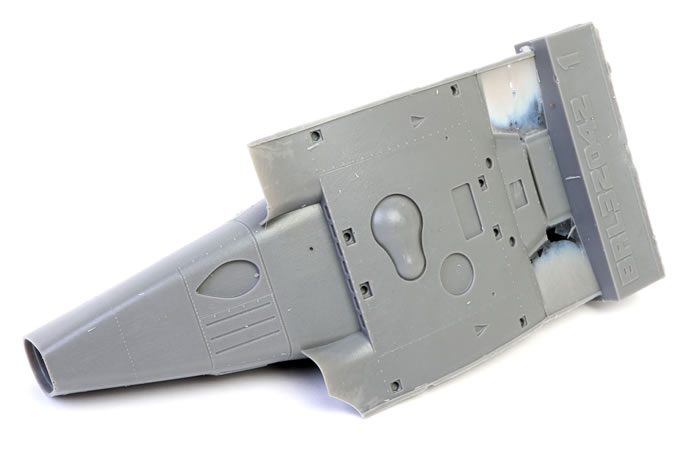
The good news is that the resin fragment was safely in the bag and will be easy to reattach and repair.
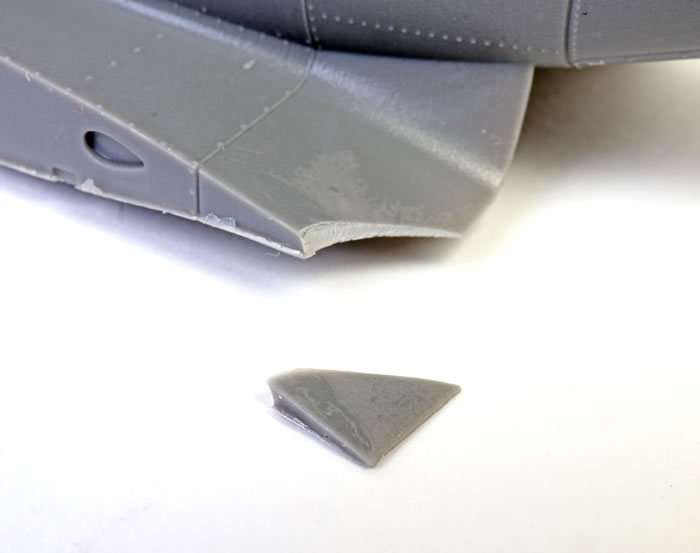
The balance of the fuselage is made up from another three substantial resin parts with the FLIR unit as a separate parts.
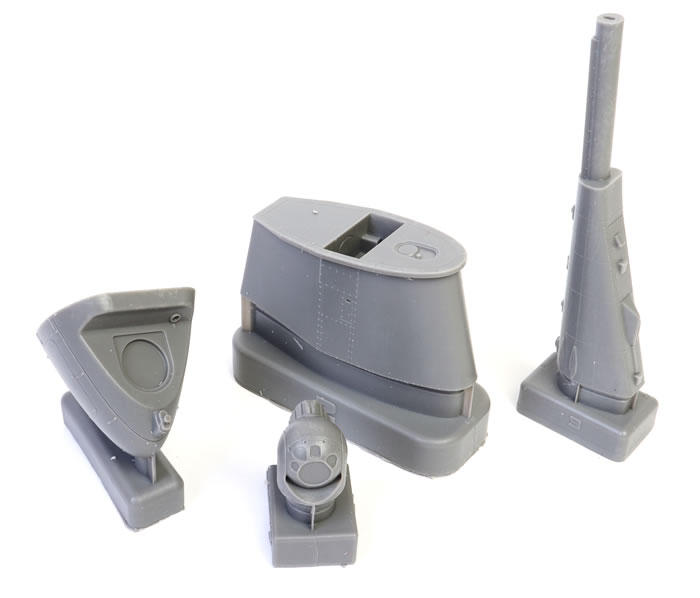
The four rotor blades are cast onto long blocks with a nice natural-looking droop.
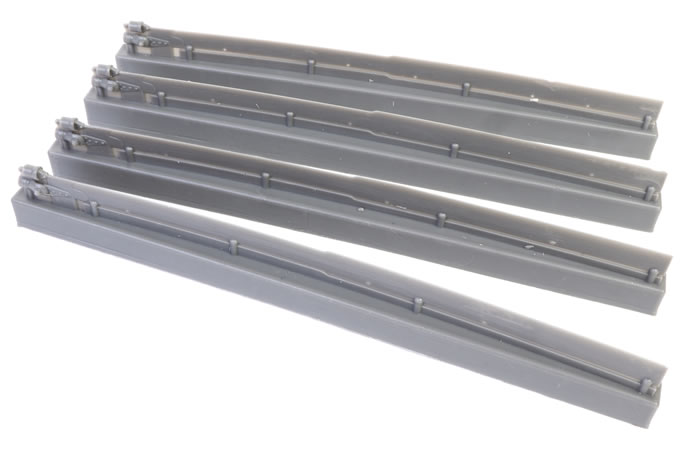
A myriad of small grey resin detail parts are also supplied.
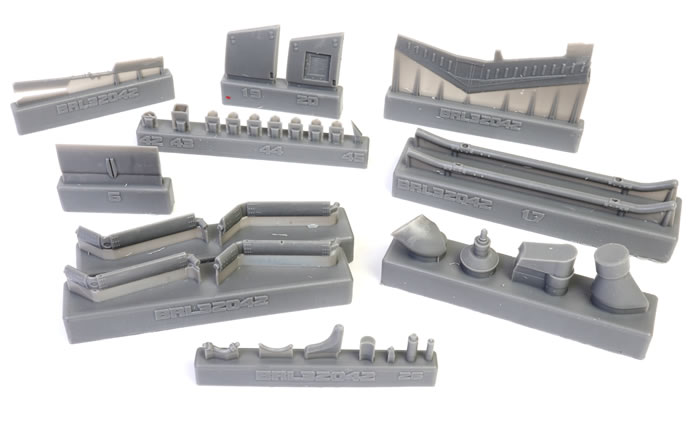
These include the skids, tail assembly and blades, avionics and much more.
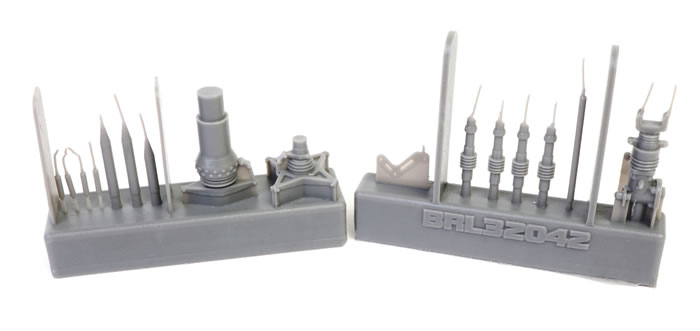
The salmon-coloured 3D printed rotor hub is exquistely details and almost ready to our straight from the box, having already freed itself cleanly from its fine strips at some time in transit.
Various lights are supplied on the clear resin strip. Seven clear parts are included.
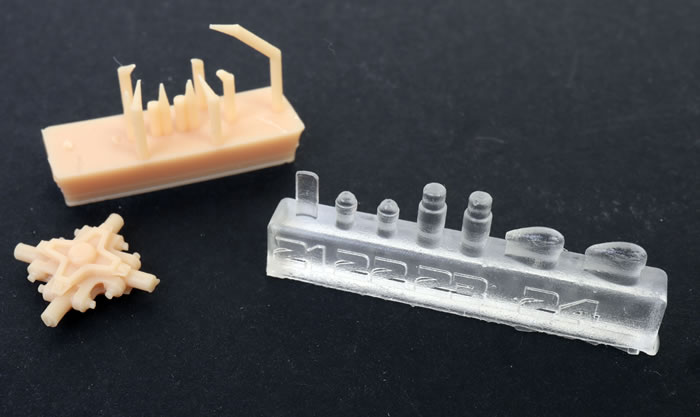
These look pretty good already but they will be further improved with a quote dip in Future Floor Polish or similar.
36 more detail parts are offered on the brass photo-etched fret.
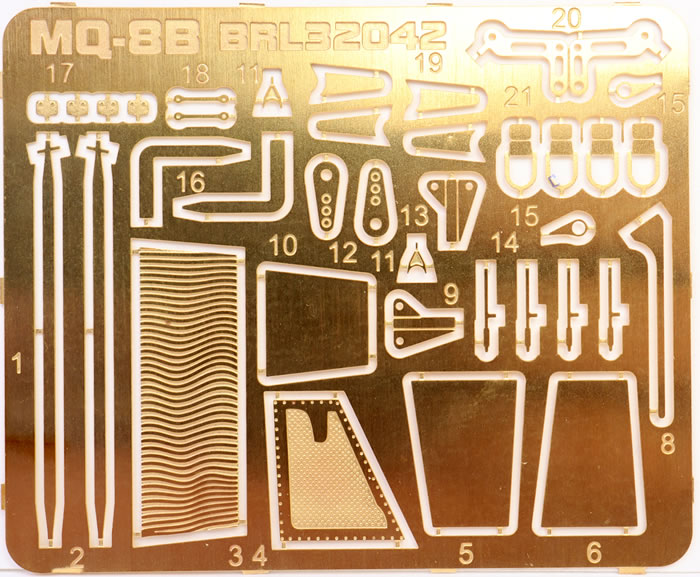
The package is rounded out with detailed instructions. These kick off with a parts diagram, followed by a busy set of assembly illustrations and finally a markings guide.
By far the most challenging aspect of this kit will be the removal and clean-up of the casting blocks on the main body sections. A Dremel tool with a cutting wheel, a razor saw, a new hobby blade and a range of sanding sticks will be your friends when dealing with the chunky blocks.
With care and time during the preperation phase though, actual assemby should be quite fast and straightforward.
Markings
The modest sized decal sheet provides markings for four overall grey Fire Scouts:
-
MQ-8B BuNo. 167792, HSM-35 Magicians, LCS-3 - USS Fort Worth, May 2013 (with instructions)
-
MQ-8B BuNo. 168445, LCS-3 - USS Fort Worth, September 2013
-
MQ-8B BuNo. 167787, US Navy Unmanned Helicopter Detachment Afghanistan 2012
-
MQ-8B BuNo. 167788, US Navy Unmanned Helicopter Detachment Afghanistan 2012
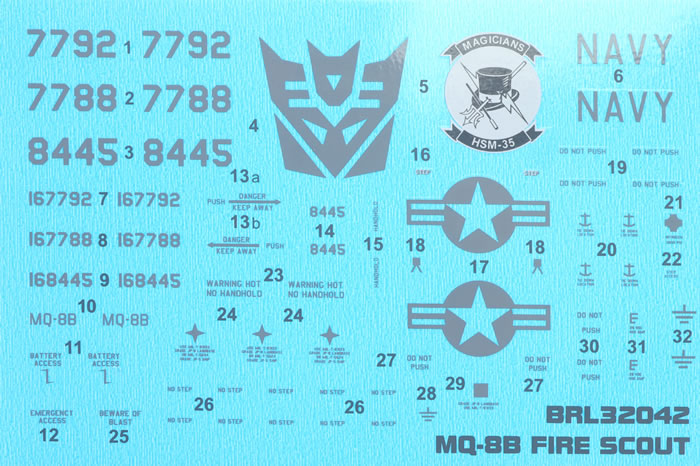
The decals are glossy, in register and perfectly printed.
Brengun's 1/32 scale MQ-8B Fire Scout is an interesting subject and a very well executed resin kit with a high level of detail.
Some experience working with resin parts will be necessary, but once the parts are removed from the sprues and cleaned up, assembly should be relatively straightforward.
This will be a unique and impressive specimen in 1/32 scale.
* Background text adapted from Wikipedia
Thanks to Brengun for the review sample.
Review Text and Images Copyright © 2021 by Brett Green
Page Created 16 November, 2021
Last updated
16 November, 2021
Back to HyperScale Main Page
Back to Reviews Page |
